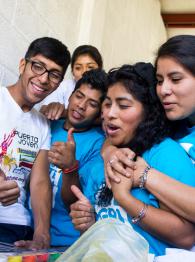
About the Project
This project is one of the 2014 WISE Awards finalists.
Rural indigenous youth in Mexico increasingly migrate to urban areas for economic reasons, often ending up in urban slums. Young people who choose -or are forced by a lack of opportunity- to migrate away from traditional lands often face double discrimination as both migrants and as indigenous people. At urban schools they face discrimination and violence because they speak an indigenous language. They are three times more likely to drop out.
Puerta Joven is an organization that promotes intercultural education based on the belief that culture and where you come from define who you are, while access to education and technology define where you can go to. The project began operating in seven Mexico City public schools in 2008, guided by an analysis of rates of violence, bullying and school dropout among the population of indigenous youth. It has been replicated in seven states in Mexico, and has been expanded to Guatemala, serving a total of more than 12,250 young people. The aim is to build school environments that support respect for cultural diversity and offer an intercultural education that keeps indigenous youth in basic education longer. At schools where the project has been implemented, the dropout rate has been reduced by 67 percent and absenteeism has dropped to 12 percent, from 84 percent before the program.
Context and Issue
Solution and Impact
The project developed a model to raise awareness and understanding of cultural differences through discussion among teachers and students using technology and creativity. With the help of a professional filmmaker, Lenguas Jovenes has established a team building structure through the creation of animated films using smartphones. Teachers and young people together develop their skills in intercultural dialogue, conflict resolution, and creative expression. Cultural diversity that flourishes in the group is identified, and then a short film is produced about the interaction that young people have achieved.
Today information and communications technology plays a crucial role in the lives of young people, giving them access to new technologies which strongly influence how they understand their environment. The project is innovative in building on young people’s use and attraction to technology. It uses the tools that young people are already using to help them reflect on their own culture, and to discuss and to assess community diversity.
Seventy-seven public schools have signed the pact for intercultural education and have implemented measures to promote intercultural harmony. The academic performance of indigenous young people in the project improved significantly. Schools where the project intervened reported that violence against indigenous youth in Mexico City fell by 84.3 percent after a school year of operation.
The attendance rate of indigenous youth increased. The positive impact was especially significant for girls who attended on average 84 percent of all classes, compared with 24 percent before implementation of the program.
Future Developments
In the coming years the project seeks to develop a new partnership with the national government to train teachers in applying the principles of the project for intercultural learning. The project is pursuing a “training trainers” strategy to produce a strong cadre of trainers for the national education program.
The project intends to expand to two more states in southern Mexico and to maintain operations in Guatemala and Bolivia. As developing countries with similar cultural histories, synergies and improved practices are more easily identified and replicated successfully. The goal is to consolidate operations in Guatemala and establish a formal partnership for the program in Bolivia. In Guatemala the project has worked with the Ministry of Culture and Education to assist local educators and schools. The pilot program in Guatemala was developed in partnership with a local youth NGO, “red ciudadana por la integridad”. The pilot program is intended to generate an extensive report of results in Guatemala in May, 2014 and to secure a three-year strategy.


